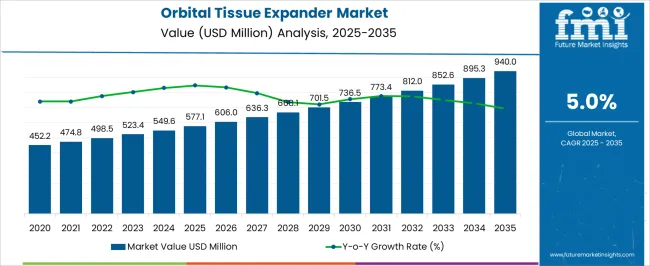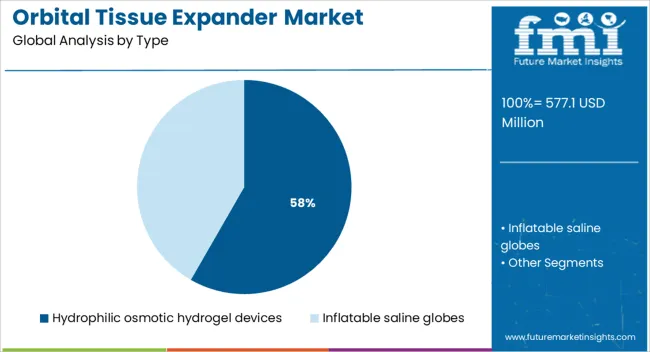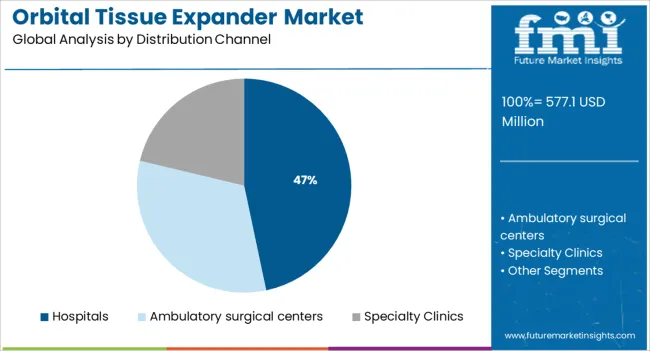The Orbital Tissue Expander Market is estimated to be valued at USD 577.1 million in 2025 and is projected to reach USD 940.0 million by 2035, registering a compound annual growth rate (CAGR) of 5.0% over the forecast period.

| Metric | Value |
|---|---|
| Orbital Tissue Expander Market Estimated Value in (2025 E) | USD 577.1 million |
| Orbital Tissue Expander Market Forecast Value in (2035 F) | USD 940.0 million |
| Forecast CAGR (2025 to 2035) | 5.0% |
The orbital tissue expander market is experiencing consistent growth driven by increasing demand for oculoplastic procedures, a rise in orbital trauma cases, and advancements in post surgical reconstructive therapies. Growing awareness among patients about aesthetic and functional orbital rehabilitation options has led to higher acceptance of expansion treatments following enucleation or tumor resections.
Clinical preference for minimally invasive and gradual expansion solutions has accelerated innovation in material science and controlled delivery mechanisms. Furthermore, the growing availability of specialist surgical care in emerging markets and improved insurance coverage are supporting procedure volume growth.
As reconstructive ophthalmic care continues to evolve, the market is expected to benefit from technological improvements, early diagnosis rates, and greater integration of biologically responsive materials in orbital devices.
The market is segmented by Type and Distribution Channel and region. By Type, the market is divided into Hydrophilic osmotic hydrogel devices and Inflatable saline globes. In terms of Distribution Channel, the market is classified into Hospitals, Ambulatory surgical centers, and Specialty Clinics. Regionally, the market is classified into North America, Latin America, Western Europe, Eastern Europe, Balkan & Baltic Countries, Russia & Belarus, Central Asia, East Asia, South Asia & Pacific, and the Middle East & Africa.

The hydrophilic osmotic hydrogel devices segment is anticipated to account for 58.30% of total market revenue by 2025 within the type category, establishing itself as the leading segment. This dominance is attributed to the self inflating nature of these devices, which eliminates the need for repeated interventions and allows for gradual and controlled expansion of orbital tissues.
The biocompatibility, minimal invasiveness, and reduced risk of infection associated with hydrogel materials have increased their preference in pediatric and adult orbital reconstruction cases. These devices enable effective anatomical restoration with improved patient comfort and shorter recovery times.
As clinical outcomes continue to favor less invasive and more predictable expansion options, the demand for hydrophilic osmotic hydrogel devices is expected to remain strong, reinforcing their leading market position.

Hospitals are projected to account for 46.70% of total market revenue by 2025 under the distribution channel category, making this the largest end use segment. The hospital setting is favored for orbital tissue expander procedures due to the need for specialized surgical expertise, access to advanced imaging and operating infrastructure, and post operative monitoring capabilities.
The rise in reconstructive surgeries following trauma, tumor excision, and congenital conditions is primarily managed in hospital environments, supporting segment growth. Additionally, the ability to manage complications and ensure multidisciplinary care has reinforced the preference for hospitals among both patients and practitioners.
With higher patient throughput, procedure reimbursement, and institutional adoption of innovative expansion devices, hospitals are expected to maintain their leadership within the orbital tissue expander distribution landscape.
The Orbital Tissue Expander Market is expected to grow exponentially during the estimated period. The orbital tissue expander are used in rare disease like anophthalmia and Microphthalmia and account around 11% of child blindness. The orbital tissue expanders are cost affective, they require minimal follow up and minor surgical adjustment.
The increasing demand for minimal intervention and rising product awareness will drive the market of orbital tissue expander market in forecast period. Orbital tissue expanders are the alternative to acrylic implant and other traditional methods used to correct congenital ophthalmologic issues. While, lack of wide availability of expanders in developing countries may affect the growth of market.
The rising demand for non-invasive methods for treatment will fuel the market of orbital tissue expander in forecast period. The traditional methods like surgery and Implants have several disadvantages like displacement of the implant, more chances of Infection of the conjunctiva. A major benefit of the orbital tissue expanders is that there is no pressure against the conjunctiva during the injections, so there is low risk of trauma to the conjunctiva.
Geographically, the global Orbital Tissue Expander Market is classified into regions namely, North America, Latin America, Western Europe, Eastern Europe, Asia Pacific Excluding Japan, Japan, Middle East and Africa
North America is expected to be the most lucrative market for orbital tissue expander owing to the presence more sophisticated instruments and technology in the region. In North America the awareness of product among people is more and this will fuel the growth of market in the region.
The Europe also has major contributes in growth of orbital tissue expander market.The market of Asia pacific will grow with high rate due to increasing government participation to provide better treatment to patient or people who are suffering from different disorders. The contribution of Latin America and Middle East Africa in orbital tissue expander in these region will be small due to less education about disease and there treatment option in the countries of regions.
Some of the major players operating in the market for Orbital Tissue Expander Market are Innovia LLC, IOP Ophthalmics, FCI Ophthalmics, Inc., Silimed, Bio-Eye Orbital Implants, Network Medical Products Ltd. Orbital tissue expander was firstly designed and implemented by Dr. David Tse Medical Director of Innovia LLC. For use in patient with ongenital deficiencies. In 2008, FCI Ophthalmics, Inc. introduced new orbital tissue expander, an inflated device for normal growth of orbital soft tissue and bone to achieve facial symmetry.
The report is a compilation of first-hand information, qualitative, and quantitative assessment by industry analysts, inputs from industry experts and industry participants across the value chain. The report provides in-depth analysis of parent market trends, macroeconomic indicators and governing factors along with market attractiveness as per segments. The report also maps the qualitative impact of various market factors on market segments and geographies.
The global Orbital Tissue Expander Market is segmented on the basis of types of Orbital tissue Expander, End User, and regional presence.
The global orbital tissue expander market is estimated to be valued at USD 577.1 million in 2025.
The market size for the orbital tissue expander market is projected to reach USD 940.0 million by 2035.
The orbital tissue expander market is expected to grow at a 5.0% CAGR between 2025 and 2035.
The key product types in orbital tissue expander market are hydrophilic osmotic hydrogel devices and inflatable saline globes.
In terms of distribution channel, hospitals segment to command 46.7% share in the orbital tissue expander market in 2025.






Full Research Suite comprises of:
Market outlook & trends analysis
Interviews & case studies
Strategic recommendations
Vendor profiles & capabilities analysis
5-year forecasts
8 regions and 60+ country-level data splits
Market segment data splits
12 months of continuous data updates
DELIVERED AS:
PDF EXCEL ONLINE
Orbital Recip Saw Market Size and Share Forecast Outlook 2025 to 2035
Orbital Action Jigsaw Market Size and Share Forecast Outlook 2025 to 2035
Orbital Shakers Market Growth – Trends & Forecast 2018-2027
Tissue Engineered Skin Substitute Market Size and Share Forecast Outlook 2025 to 2035
Tissue Paper Converting Machine Market Size and Share Forecast Outlook 2025 to 2035
Tissue Extraction System Market Size and Share Forecast Outlook 2025 to 2035
Tissue-Based Genomic Profiling Market Size and Share Forecast Outlook 2025 to 2035
Tissue Diagnostics Market Size and Share Forecast Outlook 2025 to 2035
Tissue Paper Unwinding Machine Market Size and Share Forecast Outlook 2025 to 2035
Tissue Paper Embosser Machine Market Size and Share Forecast Outlook 2025 to 2035
Tissue and Hygiene Market Size and Share Forecast Outlook 2025 to 2035
Tissue Towel Market Analysis - Trends, Growth & Forecast 2025 to 2035
Competitive Overview of Tissue Paper Unwinding Machine Manufacturers
Market Leaders & Share in the Tissue Paper Converting Machine Industry
Tissue Paper Converting Machine Market Trends – Growth, Demand & Forecast 2025-2035
Tissue Sealants & Adhesive Market Insights - Growth & Forecast 2025 to 2035
Tissue Cultured Date Palm Market Trends – Growth & Industry Forecast 2024 to 2034
Tissue Tapes Market
Tissue and Hygiene Paper Packaging Market
Tissue Roll Unwinders Market

Thank you!
You will receive an email from our Business Development Manager. Please be sure to check your SPAM/JUNK folder too.
Chat With
MaRIA